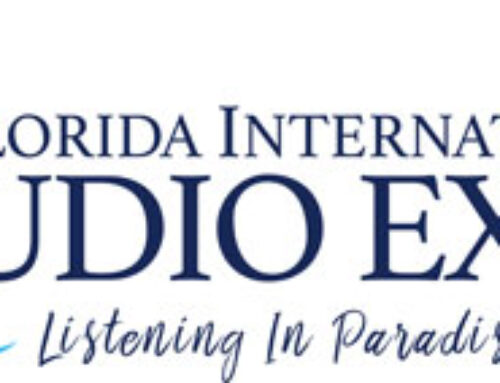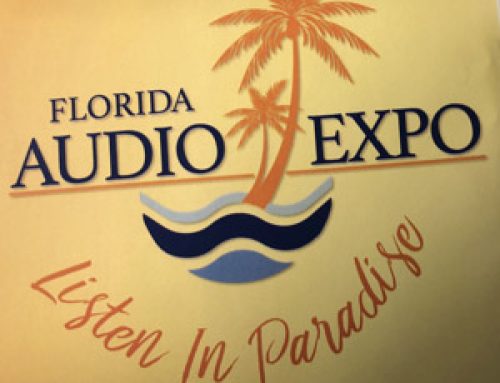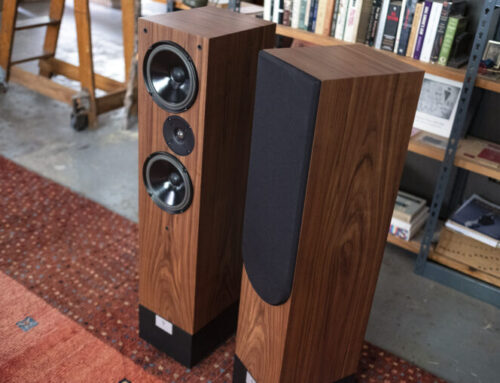The Border Patrol P20
 Way back in Issue 8, I reviewed the Border Patrol SE300B-WE amplifier, and was duly impressed, despite my skepticism when it comes to most things single-ended. Here was the first single-ended triode amplifier I’d heard that had authority at both frequency extremes and wasn’t swamped in syrupy warmth and second harmonic distortion. In fact, the SE300B was pretty much as far from traditional valve sound as it’s possible to be, whilst still retaining the dynamic virtues of thermionic amplification. It timed, it had tremendous dynamic integrity, it had superb clarity and organisation, it had eight Watts a side. Okay, so they were seriously impressive Watts, but unless you believe the “valve Watts are different to solid-state Watts” line of BS, eight Watts is still only eight Watts. And that seriously limits the available range of usable loudspeakers.
Way back in Issue 8, I reviewed the Border Patrol SE300B-WE amplifier, and was duly impressed, despite my skepticism when it comes to most things single-ended. Here was the first single-ended triode amplifier I’d heard that had authority at both frequency extremes and wasn’t swamped in syrupy warmth and second harmonic distortion. In fact, the SE300B was pretty much as far from traditional valve sound as it’s possible to be, whilst still retaining the dynamic virtues of thermionic amplification. It timed, it had tremendous dynamic integrity, it had superb clarity and organisation, it had eight Watts a side. Okay, so they were seriously impressive Watts, but unless you believe the “valve Watts are different to solid-state Watts” line of BS, eight Watts is still only eight Watts. And that seriously limits the available range of usable loudspeakers.
Since the departure of. the Border Patrol I’ve also discovered the Lamm ML2 mono-blocks, single-ended amps with a little over twice the power and around six times the price tag! Very nice they are too – as they damn well should be. They too have authority, dynamics, timing, clarity and organisation. They too sound nothing like the majority of single-ended amps. Which led me to the following suspicion. If the only single-ended triodes that I like don’t actually sound like single-ended amps at all, then perhaps I just don’t like what most people seem to like about single-ended amplifiers. Then along came The Soul (a single-ended Tetrode/hybrid amplifier of all things) and it simply underlined my conclusion. Fabulous amplifier absolutely none of the traditional SE virtues at all – except for linearity, but most SET’s have such a pathetic power delivery into bandwidth that that’s an irrelevance for them anyway.
Which begs the question, why saddle yourself with the flea-power output of the average SET if you don’t even like what it does to the signal? I couldn’t agree more. The only good SET is a properly engineered one, and those are rarer than the fabled fertilizer from the wooden horse that rocks. What people like about SET’s actually seems to be the soft sound of inadequate power supplies combined with lashings of even order harmonic distortion, rather than any intrinsic benefit from the circuit topology or output device. All very cuddly I’m sure, but I guess that when push comes to shove, I’m just a push-pull kind of guy. Which brings me rather neatly to the Border Patrol P20, a 300B amp that meets all my criteria and has recently arrived for review. Quelle surprise!
The P20 is at once much the same and twice the amp that the SE300B is, at least physically speaking anyway. The main chassis uses the same profiled wooden surround and aluminium top plate that supports the same 300B output tubes, only in this case there are four of them arranged as push-pull pairs. There’s also the obligatory choke filtered power supply, the product that established the Border Patrol name. Only once again there’s two of them, one for each channel. In fact, you can buy the amp with a single supply (as the P21) and then upgrade it later, but it’s not a simple plug-in upgrade and requires the unit to go back to the factory, so it’s the finished article that we’re considering here. And that’s just the first of a bewildering array of options that I’ll work my way through. The power supplies are each housed in a standard Border Patrol case, but are rather more complex than the more expensive of the two standard versions. Whereas the MB (M for maximum, the B I’ll leave to your imagination) supply a single discrete voltage for the amplifier’s HT, the supplies err… supplied with the P20 actually deliver five individual voltages each, two destined HT and one each for the negative bias and various heater supplies of each channel. That requires nine wires compared to the standard versions four. Each supply is matched to it’s specific channel, correct connection ensured by the use of male and female mating collars on the two captive leads attached to the amp. Each supply has a ground lift switch, a sensible move given the dual power leads required and the potential for earth loops.
One operational oddity of the amp is that, although one of the supplies acts as a master meaning there’s only one mains switch, the switch itself is located on the back of that supply making accessibility something of an issue if you prefer to power your equipment down. Unfortunately, there’s physically no room to move the switch to the front panel and it would mean disturbing the preferred wiring layout, separating DC from AC. The other unusual feature is the volume control option. This consists of a chromed knob mounted centrally in the front of the amps plinth connected to a stepped attenuator. This allows direct connection of a single source, allowing users in this happy circumstance to dispense with the cost and complications of a line stage. Alternatively, the amp is available with a standard fixed input of a lower sensitivity intended for driving from a pre-amp. Twice the output tubes and the push-pull topology delivers slightly more than twice the power and that adds up to 20 Watts of class A grunt, which is far more familiar territory as far as I’m concerned. The amp arrived with a matched quartet of Western Electric 300Bs and an additional set of mesh-plate Gold Dragons, a cost and qualitative option that I’ll get to later. Otherwise there’s a CV4068 input valve supplying a Mullard E182CC driver which feeds the inter-stage phase splitter transformer. Using a transformer instead of a valve to split phase affords greater accuracy, time consistency and zero feedback.
Connections consist of a pair of RCA phono’s for the input and decent 4mm binding posts with four and eight ohm output options. One speaker that worked a treat with the SE300B was the resident Living Voice OBX-R, which was also on hand to try with the P20. But given the additional power available I was fascinated by the results with a wider range of partnering speakers. To that end I tried the Reference 3A DeCapo’s (fairly sensible) the Alon Lotus Elites (sensible if we stretch our credibility a bit) and the KEF Reference 207s (not sensible at all). I ran the P20 mainly from The Vibe line-stage, but also direct from both the Wadia 861 and Groove and Vendetta Research phono-stages. Cabling was Nordost Valhalla throughout.
It’s a while since I had the SE300B at home and aural memory is a notoriously fickle thing, but what sticks in the mind (apart from its almost astringent neutrality – if the Vatican made amps then this would be it: complete with in-built guilt as regards any flights of fancy or unwarranted addition) is the gusto with which it delivered every one of its eight Watts. There’s a world of difference between sounding powerful and actually being powerful. Indeed, the effect is all too often the exact opposite of the fact, and the SE300B took this to extremes. It got there so fast with so much, that, whilst it never seemed to run out of steam (at least with a sensible load attached) you were frequently aware of the edge of the envelope and the precipice beyond. The P20 is a totally different kettle of fish. It has twice the power and its push-pull output stage brings a greater sense of focus and leading edge definition. The result is an amp that offers virtually all of the attributes of its single-ended sibling, but grafts on a sense of ease and poise combined with more emphatic dynamic contrasts. It’s as if the music has been brought within its compass, and along with that comes a confidence in the placing and level of notes. There’s more space around each note, in both dimensional and temporal terms, making each one easy to hear, along with relationship to the next. It simply makes life easier.
That handles the ease and poise: what about the emphatic dynamics? Well, at the same time that things become easier to hear, they happen faster too, so you have the slightly unusual situation that the music sounds slower in tempo but the amp is actually quicker. Think about it for a second and it all makes sense. If the notes start and stop quicker then you get longer (and more precise) spaces in between. The dynamic window is wider too and the increased sense of power and substance combine to create a showier, more immediately engaging and inviting sound. The musical performance becomes more dramatic, the playing more demonstrative.
Playing the Classic Records re-issue of the Cannonball Adderley classic Somethin’ Else (Classic Records 200g/Blue Note 1595) the sound is big and stable, the bass really well grounded (it’s those power supplies again). Autumn Leaves’ opens with a beautifully measured limping walk of a bass-line, laid out in the piano’s left band and shadowed by Sam Jones on bass. The P20 gets the rolling rhythmic gait just right, the slight slowing… then the speeding up, but never, ever dragging. The two instruments are distinctly separated, and that’s down to tonal and textural definition on this mono disc. Miles’ horn entry is unmistakable. The tone is spot on, the poise and spacing of the simple melody Nobody plays quite like Miles, and the contrast between his pure cool and the dirtier, fruitier bop-style of the Cannonball is what gives this quintet its special flavour, an evolution of the chemistry that fuelled his earlier outings with Charlie Parker. (No! Not that chemistry) It’s the subtle nuances cal relationships that Patrol effortlessly reveals. But what makes it special is the energy it brings to the fun it has doing it. The clarity and stability that come from the firm bass foundation extend way up the range too. Art Blakey’s stylish yet discrete cymbal work is one of the great pleasures to be had from Somethin’ Else, and the P20 makes the most of his contribution, keeping it in the right lace and perfectly in proportion. Female vocals are similarly well served; gaining air and delicacy revelling in the musical space the amp allows them.
Play Breaking Silence (Analogue Productions APP 027) with Janis lan’s fragile vocals caught in the dynamic spotlight of sudden shifts in level, and you’ll see what 1 mean. The music gains drama from the contrast and emotional power as a result. And 1 know I’ve already talked about the bass at some length, but you really should hear the bass lines on this album. Hear them that is, in the sense of around, behind and beneath the notes. Tactile? I should co-co.
Whilst the P20 will drive a wider range of speakers than the smaller SE, to hear it at its best, you’ll still want to play it with something reasonably efficient. Impressive with the KEF Reference 207s, it was downright spectacular with the Reference 3As and the latest Living Voice OBX-Rs. Here, the authority shape, pacing and tactile presence that the P20 brought to the nether regions of these physically modest speakers imbued them with a scale and sheer unflappable stability totally at odds with expectations. Tonal colour and separation were superb, with none of the qualitative sameness that collapses the individual character and texture of instruments (and performers). The P20 will never have the air and clarity the detail and transparency of the Hovland Radia. But then the cool American will never have the presence, energy and sheer musical gusto of the Border Patrol. What the P20 provides is the tonal sophistication and lack of colouration enjoyed by the SE300B, but coupled to a serious dose of authentic musical energy and improved focus and dynamic snap. Substituting the Mesh Plate Golden Dragons should bring added air, delicacy and fineness at the expense of some of the presence and sheer clout. I ran out of time to try the swap, but with meat to spare and based on past experience I feel that the P20 fitted with the Chinese valves offers a serious alternative to the Western Electrics, providing a different but qualitatively equal view of musical events. Cheaper too!
The P20 is a mightily impressive amplifier and one that explodes the triode myth. Once again, it proves that it’s not what you use but how you use it that counts. Good engineering will win out. I’ve listened long and hard to the push-pull Border Patrol and still haven’t got its full measure. And that’s without the Mesh Plate option, which I’ve a sneaking suspicion I’ll ultimately favour. Then of course there’s the S20, the parallel single-ended version of the same beast. There’s more, much more, to come…




Leave A Comment